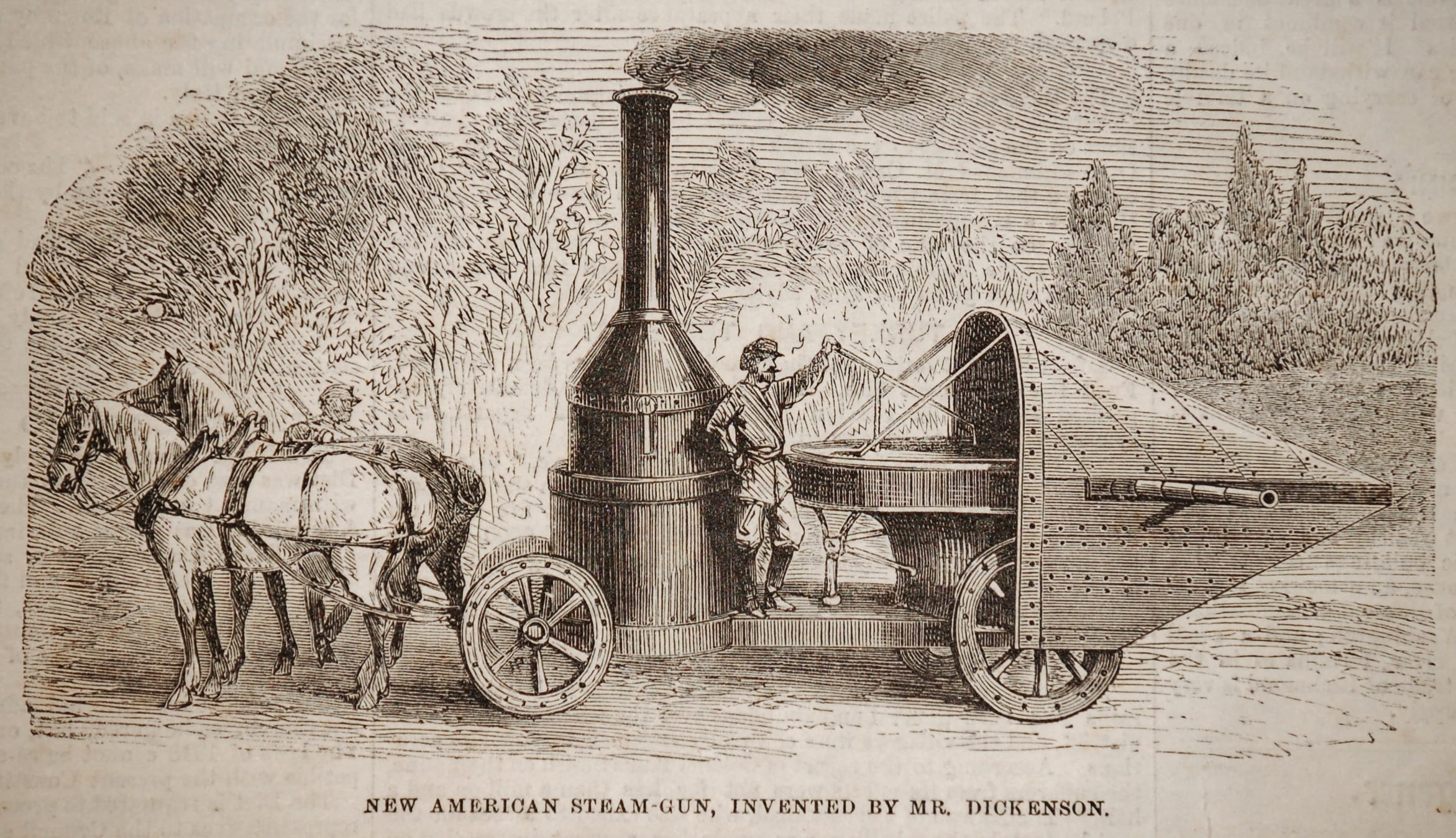History buffs, prepare to be captivated by the intriguing tale of the Winans Steam Gun. This peculiar Civil War-era weapon, designed to unleash destruction through centrifugal force, never actually saw combat. Join us as we uncover the story of ambition, innovation, and the limitations of 19th-century technology that shaped the fate of this enigmatic weapon.
Unraveling the Mystery of the Winans Steam Gun
The Winans Steam Gun—the name itself evokes images of a bygone era of invention and ingenuity. Imagine a massive, steam-powered apparatus, resembling a locomotive more than a cannon, capable of spitting out projectiles with incredible speed. This, in essence, was the ambition behind the Winans Steam Gun, a weapon designed to harness the power of centrifugal force to dominate the battlefields of the Civil War.
Our story begins in 1858 when inventors William Joslin and Charles S. Dickinson patented their groundbreaking steam gun. Ross Winans, a Confederate sympathizer, later became involved in the construction process. Despite not being the original inventor, Winans’s name became inextricably linked to the weapon, leading to frequent misattributions.
The Winans Steam Gun was a sight to behold—a massive structure with a distinctive curved shield and a rotating barrel that hinted at its unconventional nature. The operating principle was as intriguing as its appearance. Projectiles were spun at incredibly high speeds inside the rotating barrel, generating powerful centrifugal force. At a precise moment, these projectiles would be released, flung outward with considerable force.
However, the reality of the Winans Steam Gun fell short of its ambitious goals. Generating the steam pressure required for operation was a logistical challenge, and even when achieving optimal pressure, the firing rate remained slow. Perhaps most detrimental was the gun’s notorious inaccuracy. The high-speed rotation, while effective for generating force, compromised the projectiles’ trajectory, making it unreliable for long-range combat.
As the Civil War erupted, the Winans Steam Gun, despite the initial hype, remained a work in progress. Union forces seized the unfinished weapon, relegating it to a curious relic of the war—a testament to ingenuity but not a viable tool for battlefield dominance.
Despite its shortcomings, the Winans Steam Gun captures the spirit of innovation that pervaded the Civil War era. This steampunk-esque creation, though flawed, embodies the relentless pursuit of technological advancement that characterized this turbulent period. Its legacy persists, not in battlefield victories, but in the realm of imagination, inspiring books, art, and even modern engineering projects exploring the potential of centrifugal force.
Today, a full-scale replica stands as a tribute to the Winans Steam Gun in Maryland, a reminder of its unique place in history. The gun’s story is a testament to the fact that even failed inventions can ignite our imaginations and highlight the boundless ingenuity of the human mind. It reminds us that sometimes the most captivating stories are those that took unexpected turns, leaving behind a legacy of “what ifs” and a profound appreciation for the audacity of innovation.
How Did the Winans Steam Gun Work?
The Winans Steam Gun, a fascinating relic of the Civil War, attempted to revolutionize warfare by harnessing steam power for projectile propulsion. Unlike traditional cannons that relied on gunpowder, this unique weapon employed the principles of centrifugal force to launch its deadly payload.
Imagine a bucket filled with water being swung rapidly in a circle. The water, despite being upside down, remains inside the bucket due to the outward force generated by the spinning motion—this is centrifugal force in action. The Winans Steam Gun applied this same principle, but instead of a bucket, it utilized a spinning barrel loaded with projectiles.
At the heart of this contraption lay a powerful steam engine that spun the barrel at incredible speeds. Projectiles were fed into the top of this rotating barrel, and at a precise moment, a spring-loaded gate would release them from the side. The centrifugal force generated by the spinning motion acted like an invisible hand, flinging these projectiles towards their intended target.
This ingenious mechanism allowed for a rapid rate of fire, exceeding 250 projectiles per minute—a significant advantage over traditional artillery. However, the Winans Steam Gun’s Achilles’ heel lay in its accuracy. The very force that enabled its impressive firing rate also introduced a significant degree of unpredictability in the projectiles’ trajectory, making it highly inaccurate, especially over long distances.
This lack of precision, coupled with the logistical challenges of maintaining a constant supply of steam power on the battlefield, ultimately led to the gun’s downfall. While the Winans Steam Gun may not have achieved battlefield glory, it remains a testament to the ingenuity and ambition of its creators, forever etched in history as a daring, if ultimately flawed, attempt to revolutionize warfare.
Could Steam Power Have Changed Warfare?
The Winans Steam Gun, a fascinating relic of the American Civil War, poses a compelling question: could steam, the driving force behind the industrial revolution, have also dominated the battlefield?
This behemoth of a weapon, resembling a steam locomotive more than a traditional cannon, attempted to harness the raw power of steam to propel projectiles. Instead of relying on the explosive force of gunpowder, the Winans Gun employed centrifugal force generated by a rapidly spinning barrel.
While innovative in concept, the Winans Steam Gun faced significant hurdles in practicality and effectiveness. The rate of fire, though potentially impressive, was hampered by the time required to generate sufficient steam pressure. The lack of accuracy, a consequence of the high-speed projectile release, proved to be a significant drawback in the context of warfare.
The limitations of the Winans Steam Gun highlight the complexities of adapting novel technologies for military applications. The allure of steam power, so evident in its transformation of industries, couldn’t overcome the fundamental challenges of accuracy and efficiency in a battlefield scenario.
Despite its shortcomings, the Winans Steam Gun stands as a testament to the human spirit of innovation, a symbol of the relentless pursuit of technological advancement, even amidst the chaos of war.
What Was the Purpose of a Steam Gun?
During the technological fervor of the 19th century, the advent of steam power sparked a wave of innovation across various industries, and weaponry was no exception. Inventors, captivated by the possibilities, explored the potential of “steam guns” as a revolutionary alternative to traditional firearms.
These steam-powered weapons, utilizing pressure generated by heated water to propel projectiles, promised a new era of warfare. The concept, while seemingly far-fetched, was rooted in sound engineering principles. By harnessing the force of expanding steam, inventors sought to create weapons with greater firing rates and potentially devastating power.
One notable example, the Winans Steam Gun, emerged during the American Civil War. This behemoth of a weapon, resembling a steam-powered fire engine, aimed to provide the Confederacy with a decisive advantage. However, the reality of steam gun technology fell short of expectations. Accuracy remained a significant challenge, and the logistical complexities of generating and maintaining sufficient steam pressure on the battlefield proved impractical.
While the dream of steam-powered warfare ultimately faded, it underscores the boundless capacity for human ingenuity. The story of the steam gun serves as a reminder that even in the pursuit of more effective means of destruction, innovation and imagination often lead the way.
When Was the Steam Gun Invented?
The story of the steam gun begins not with a deafening blast, but with a spark of ingenuity in 1858. It was during this year that inventors William Joslin and Charles S. Dickinson, hailing from Ohio, filed a patent for a groundbreaking new weapon: a centrifugal gun powered by hand.
This initial design, while promising, lacked the power to inflict significant damage. However, it laid the groundwork for what would become the more widely known Winans Steam Gun. It was Dickinson who, after parting ways with Joslin, secured funding to construct a steam-powered prototype in Boston in 1860. This marked a pivotal moment in the evolution of the steam gun.
While the Winans Steam Gun often receives the lion’s share of attention, it’s crucial to acknowledge the vital contributions of Joslin and Dickinson, the true pioneers of this fascinating, if ultimately unsuccessful, chapter in the history of weaponry.
Want to Dive Deeper into Pearl Harbor History?
If you’re interested in exploring more about Pearl Harbor and its significance, check out our detailed directions to Pearl Harbor from Honolulu. This guide provides everything you need to know about planning your visit to this historical site.
- Red Cloud, NE: Discover Willa Cather’s Legacy - April 11, 2025
- Remember Old Social Media Sites? Their Rise and Fall - April 11, 2025
- How many days till Feb 3?Accurate Countdowns & Tools - April 11, 2025
















